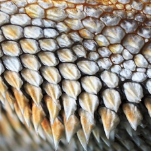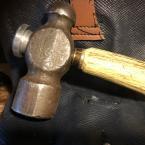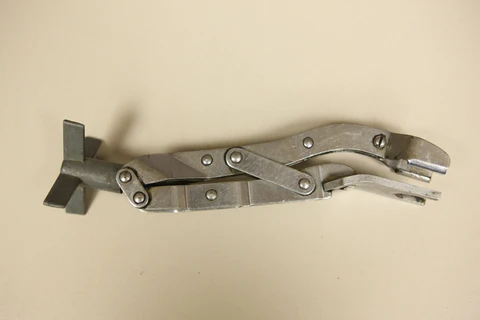All Activity
- Past hour
-
Chicago screw is a simple fastener. A simple solution is in order. Chicago screws with a rubber washer is fine, if you want to buy them. In the mean time, if the only C screws you have don't include a rubber washer, simply use a small drop of rubber in the spot where the washer would fit. Give it a couple minutes to dry, and voila, you have a rubber washer, thanks to the rubber cement you likely already have on hand. C screws dont need to be real tight, either. I get good results simply holding the base with a fingertip while I tighten the screw.
- Today
-
@WyomingSlickThanks for the list.
-
The book has proved to be popular. He should be able to find a publisher. So many people looking for it.
-
Out of stock on both sites. Hasn't been on his Facebook site since 2022. https://www.facebook.com/profile.php?id=100067802724697
-
You can get the book from Leather Crafters Journal: https://leathercraftersjournal.com/product/creating-western-floral-designs-bob-park/ Barry King Tools: https://www.barrykingtools.com/patternpacks.htm Bob Park also sells the book. Go to his Facebook page. Good Luck
-

Is B69 thread thick enough for use attaching bag handles?
AEBL replied to AEBL's topic in Sewing Leather
She'll be happy about her bag being safe-ish for lugging all of the stuff she lugs around, for sure. I'm seeing how much of an engineering problem this is ... and I'm liking it more. Makes me want to set up some stitch samples and a set of weights and take some failure data. I'm sure it also depends on tannage and thickness somewhat. Very neat. -
Lol. I see your concern, and you are right!! I know the mechanic only drinks DP. So that must belong to the owner
-
ledburner joined the community
- Yesterday
-

Best way to tighten Chicago Screws?
Brokenolmarine replied to DeWayne Hayes's topic in How Do I Do That?
I bought molar extraction pliers on amazon to use for removing rivets in leather if I messed them up, or had a belt or holster in need of repair. The pliers work great to hold the edge of chicago screws for removal or installation as well. https://www.ebay.com/itm/305751247935?_trkparms=amclksrc%3DITM%26aid%3D1110006%26algo%3DHOMESPLICE.SIM%26ao%3D1%26asc%3D285767%2C285774%26meid%3D298bd0996e484e2fbddec7d542b1d7d4%26pid%3D101875%26rk%3D2%26rkt%3D4%26sd%3D182953450010%26itm%3D305751247935%26pmt%3D1%26noa%3D0%26pg%3D2332490%26algv%3DSimVIDwebV3WithCPCExpansionEmbeddingSearchQuerySemanticBroadMatchSingularityRecallReplaceKnnV4WithVectorDbNsOptHotPlRecallCIICentroidCoviewCPCAutoVisionMM&_trksid=p2332490.c101875.m1851&itmprp=cksum%3A305751247935298bd0996e484e2fbddec7d542b1d7d4|enc%3AAQAKAAABkO7WQzztPwW6PkgoYfQkPoIk8LPijUJeRSIaSsdtf4xtPJNwHvvrPnsdhIFEZLwP5X%2F0pqGkKRfiBPA92WLZSaWJeHJ6aHHpPmFFOZkbwiXNGDpreUeBHj2ZrDtFEH2%2BiQkXd3wmf1Lc3IzYTN6YW7me6RU%2FP2u4AIJjtMZpnUzn4fhxgZX8ivT%2BPzOsmjM85UZKRXWhewCBubf%2BsyilGjaJ%2BzPLyJ%2FXGatWAXsIqKS6NE7db6iQ8EnwvRAVG7ukfzpB2qNIpLQNZKJk1Ek8hRV71npOShk8oJ6p7MS8wWnmyyBcw2x%2BeGObQfj32zBa%2BW4UlVAdmXMVIJBEP6HxygToGqbgmzEwryleDTx02LbsuJ9ZW671Pn%2FLd0dlgHnnYOJF%2F9rTzlQ5A2YjOBuymmuBNMsyRO5T7Mlr71Ms1AldhCNO%2Fja6FFnULy8tgeZLdHLwEQvRNwPdo8Es5m%2FIuvVLgLsVM1XsQJ9nHyYCrvPO0MoB%2FbiNDEjFWeBNvY7SOL8jHFjOBxQltjesIrJTvFQ%3D|ampid%3APL_CLK|clp%3A2332490&itmmeta=01JV0TGDRAC7235XN51PXGN1JP -

Is B69 thread thick enough for use attaching bag handles?
AlZilla replied to AEBL's topic in Sewing Leather
As a practical matter, I believe the strap is going to stay safely on the lady's handbag. -
Is B69 thread thick enough for use attaching bag handles?
kgg replied to AEBL's topic in Sewing Leather
This formula can very misleading as it was develop mostly for fabric and indicates that by increasing the number of stitches per inch increases the seam strength it leaves out the practical factor before you damage / weaken the material, fabric or leather. As a note the strength factor would be 1.7 if you were using a Chainstitch machine. Using the formula in that article for Lockstitch machines: i) 6 stitches per inch x V92 having a breaking strength of 14.5 lbs x the strength factor= 130 lbs / inch ii) 20 stitches per inch x V92 having a breaking strength of 14.5 lbs x the strength factor= 435 lbs / inch The stitches per inch is stitch density and for leather it is recommend the stitch density should not be more then 3 to 4 per cm which converts to 6.35 - 8.46 stitches per inch. The reference article for this is Schmetz, Sewing Focus Technical Sewing Information -- Section 3.3 ( https://www.schmetz.com/mm/media/zh/web/7_tochtergesellschaften/bilder_18/schmetz/pdfs_4/sewing_focus/SewingFocus_20_3075-22_Lederbekleidung_D.pdf ) kgg -

Scoped super blackhawk/freedom arms 83 shoulder holster
Hags replied to DoubleKCustomLeathercraft's topic in Show Off!!
Pretty slick!- 6 replies
-
- 44 mag
- freedom arms
- (and 4 more)
-
Oh. So there is no way it can get printed again? I wonder.
-
sojourner999 started following How much is this worth?
-
I was the person who bought an old Chandler cu563. it was not a good purchase decision on my part. I was new to purchasing industrial triple feed machines and similarly new to sewing. I was naïve. It was beat up, ridden hard and put away wet. The needle bar had all kinds of slop, stuck on one stitch length, hook tip was broken off. It had so much wear, the table was seriously worn down where the fabric moved over the table. It was really beat up. It sits in a storage unit. I was able to get a genuine Juki 563 with very little usage for $200. Deal of the century for me. aside from being beat up, I did a little fabri-cobbling to install a syncronized binder (khsew) for fabric binding. I had to dremel away a little bit of metal on the feed dog fork so the binding feed dogs could be installed. With the Chandler, a dremel cut through that metal like a hot knife through butter in a half-second. when I did the same on the genuine Juki 563, it took forever and a day, multiple sessions, and lots of sparks and cursing and muttering before I barely had enough dremeled out to fit the feed dogs. that take away for me was that Chinese metal (at that timeframe) is extremely soft compared to a genuine Japanese Juki. I cannot speak to the quality of the machine you are looking at. It may be in great condition and not used too heavily. That said, I would definitely pay less than what I would pay for a genuine Juki 563. personally, unless this is new-old-stock or almost new condition or a couple hundred dollars (no more than. $250), I would pass and wait for a juki. just my 0.02 goos luck.
-
Yes, that would help. Thanks
-
While I don't have one for sale, I also have a 545 H3 and could take some pictures of it for you if that would help.
-
Maybe you could provide a little more information and pictures to help identify it and see what condition it is in. Here is some information from an old thread.
-
It was privately printed by/for Bob Park, not by a publishing house. No ISBN number.
-
Thank you
-
.thumb.jpg.6e903dd66163ad5672f00f144058c571.jpg)
Best way to tighten Chicago Screws?
Northmount replied to DeWayne Hayes's topic in How Do I Do That?
That is similar to mine. Below is the style my Dad used (for valve in block). Neither of these would make a good tool for Chicago screws. -
I wonder why it went out of print. It is shown in Amazon as out of stock. It seems so popular and everyone wants it.
-
The 25 kV line down my back lane (Calgary AB) is 3 conductors only. Drops are made to transformers along the way. The transformers are connected between 2 phases (resulting in single phase delivery) on the 25 kV line, and deliver 110V - 0 - 110V via 3 conductors. (The 0V lead is the N (neutral typically white) conductor.) Overhead drops to houses are via triplex cable. Connection across the two 110V conductors provides 220V which is typically used for heavier loads like electric stoves, clothes dryers, air conditioners and shop tools like table saws and air compressors. As the 25 kV line continues down the lane, transformers are connected to the next pair of phases, and onto the next pair, providing a balanced load on the 3 phase system. It is more economical to use 3 phase transmission as currents flow counter to each other as you look at the actual current flows, reducing the cable diameters versus what would be needed in a single phase system to transmit the same amount of power. In commercial and industrial applications, utility power (110V lighting, receptacles, small motors, etc.) is often distributed as 208V three phase wye connected. 120V power is available by connecting to one phase and the center tap of the wye connection. 120V and 110V terms are used interchangeably, as is 220V and 240V in many discussions and specifications as they are within design tolerances. During my electrical education many years ago, what we now call 110V or 120V was simply called nominal 117VAC.
-
Moved your post to leather sewing machines. You are much more likely to get help here than in leatherwork general conversation.
-
Tozamel joined the community
-
How much is a Chandsew CU563 worth?
-
Thanks everyone. I picked I the foam trick from road agent leather on YouTube. I've watched a few of his videos where he's mentioned, and/or shown himself using foam. It's just one if those things that slipped the mind until recently, when I made a holster than didn't function correctly. Now I'm keeping foam on hand. It only takes a couple mistakes to wise up hahaha
- 6 replies
-
- 44 mag
- freedom arms
- (and 4 more)
-
Peppe Peppe changed their profile photo
-
Peppe Peppe joined the community
-

Is B69 thread thick enough for use attaching bag handles?
AlZilla replied to AEBL's topic in Sewing Leather
Here's a dissertation on seam strength: https://www.sailrite.com/How-to-Sew-Webbing-Loops Sailrite says "Stitches Per Inch x Breaking Strength x 1.5" = Seam Strength Per Inch I think your wife's handbag is going to hold up.






